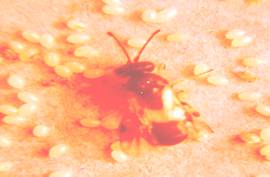Bio control:: Mass production::Parasitoids
| Mass production of Chelonus blackburnii |
|
Introduction
 |
-
C. blackburnii is introduced from Hawaii. A parthenogenetic egg-larval parasitoid, C. blackburnii has a fairly wide host range but in India the common meal moth Corcyra cephalonica and potato tuber mothPhthorimaea operculella have often been used for multiplication of this parasitoid.
-
It could also be multiplied successfully on Spodoptera exigua. C. blackburnii has been used for the biological suppression of P. operculella, Earias vitella, Pectinophora gossypiella and Helicoverpa armigera on cotton and other host plants in many states.
-
It is becoming an important component of IPM systems on potato, cotton, etc.,
|
Production procedure
- A set of 100, 0-24 hr old eggs of Corcyra (not exposed to UV) are pasted to 5 x 5 cm card. This card containing eggs is exposed to 30 C. blackburnii adults in a 1.5 l container.
- The plastic container has windows with plastic mesh for aeration. Two cotton swabs, one soaked in 10% honey solution and the other in drinking water are also placed inside from the side opening which is closed tightly with a cloth covered cotton plug.
- The egg card after exposing to C. blackburnii for 24 hrs is removed and placed on 500 g sterilized cumbu medium. In 30 days time, adults start emerging from the cocoons formed in the cumbu medium after completing development on Corcyra larvae. The adults live for 25 days and their fecundity is about 400 eggs.
- The parasitoid could also be reared on potato tuber moth (PTM). A set of 1500 egg of laid on a cloth are stapled to a card.
- This card containing 0-24 hr old eggs is exposed to 30 C. blackburnii adults. The plastic container (14 cm x 11 cm) is converted into C. blackburnii rearing unit by cutting windows and fixing plastic mesh aeration.
- Two cotton swabs, one soaked in 50% honey solution and the other in drinking water are also placed inside from the side opening which is closed tightly with a cloth covered cotton plug.
- The PTM egg card after exposing to C. blackburnii for 24 hrs is removed and placed on punctured potatoes. This provides more entry points for PTM larvae and kept in a similar plastic container as described for exposure to C. blackburnii.
- The bottom of this container is lined with sterilized sand. In 25-27 days time, adults start emerging from the cocoons formed in sand at the bottom of the cage or sometimes inside potatoes after completing development on potatoes.
- The adults live for 23-31 days and their fecundity is about 288-390. Parasitoid host ratio of 1:50 should be maintained and the fresh lot of eggs provided every day.
|
|

